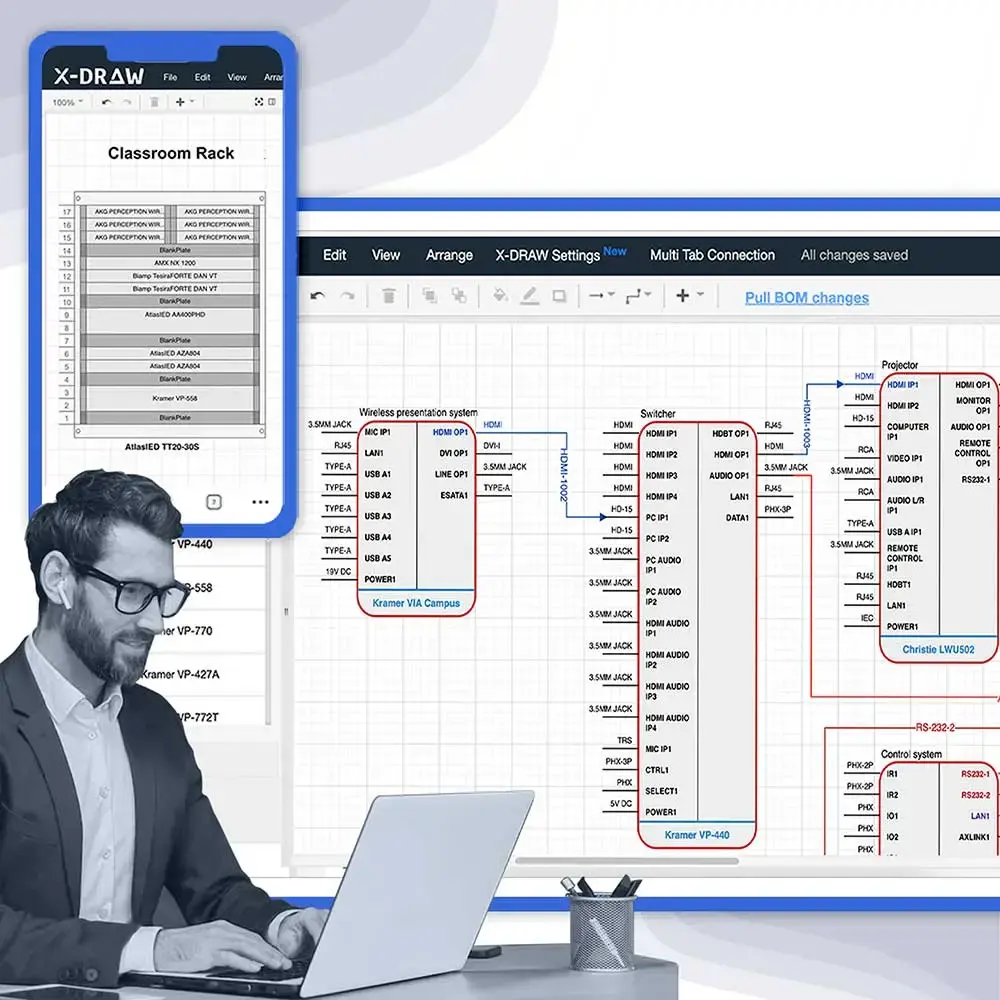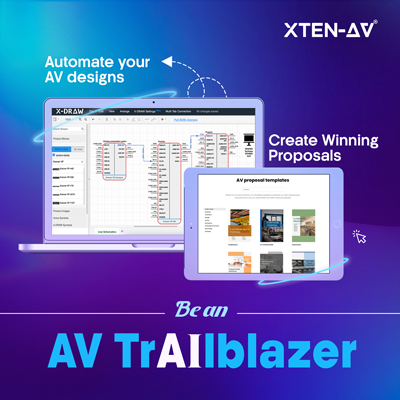BAS System Design Hacks: Optimize Your Building Automation Projects
Are you struggling with effectively managing building systems for occupant comfort and energy use? Managing the various systems running within a building can be overwhelming at times and usually results in inefficiency, adding up to higher operational costs. There is, however, a solution to help level these operations for better building performance.
Ensuring even coverage, balancing sound quality with budget constraints, and complying with noise regulations – it’s a lot to juggle.
At XTEN-AV, we understand these struggles. Our AV design software is tailor-made to help you overcome these challenges and create a sound system that elevates the customer experience, boosts revenue, and sets your venue apart. Our team of experts is available to provide guidance and support throughout the BAS system design process.
In this article, let’s delve into the critical factors and design principles involved in creating a Building Automation System (BAS) perfect for your building.
Key Takeaways
- A Building Automation System (BAS) is a network that controls and manages various building functions for optimal efficiency and comfort.
- Careful planning, expert design, and ongoing monitoring are crucial for a successful BAS system implementation.
- XTEN-AV’s building automation system design software can significantly accelerate BAS project timelines and improve design accuracy.
AV Design Mastery + Winning Proposals = 10x Productivity!
- Automatic Cable Labeling & Styling
- 100+ Free Proposal Templates
- Upload & Create Floor Plans
- 1.5M Products from 5200 Brands
- AI-powered ‘Search Sense'
- Legally Binding Digital Signatures
No Credit Card Required
What are Building Automation System?
Building automation systems (BAS) are intelligent networks that centralize control of various building functions like HVAC, lighting, security, and more. BAS system leverages automation system design to optimize energy efficiency, occupant comfort, and operational costs.
Through sensors, controllers, and software, BAS regulates the building operations. This leads to reduced energy consumption, improved indoor environments, and smoothened maintenance, ultimately contributing to a more sustainable and cost-effective building operation.
Importance Of Building Automated System
A building automated system is not a number of devices connected but a basis of today’s building management. It is capable of effectively improving your property’s efficiency, comfort, and overall performance by automating a variety of building functions.
A robust building automation system architecture offers several key benefits:
- Energy efficiency: Through smart control over HVAC, Lighting, and other systems, you can cut down energy use and save utility bills.
- Cost reduction: Through optimized building operations, BAS reduces maintenance costs and prolongs asset life.
- Enhanced comfort: The BAS creates a comfortable, productive environment for building occupants by maintaining temperature, humidity, and air quality at ideal levels.
- Improved safety: The integrated security systems monitor in real-time, thus improving building security and emergency response.
- Data-driven insights: BAS system design produces enormous amounts of valuable data that can be harnessed and used to find areas for improvement and optimize building performance.
What to Consider When Designing a BAS System?
A building automation system project is one of the giant steps toward meticulous planning and consideration. There are several BAS system design factors that can influence the success of your project.
Assessing Your Building's Needs
Begin with assessing the specific needs of your building. Some things to consider include:
- Building size and complexity: Larger buildings typically require more advanced BAS solutions.
- Existing infrastructure: Knowing the existing systems within your building and how they can integrate is an essential element of this process.
- Energy consumption patterns: Use energy usage data to determine areas of optimization.
- Occupancy patterns: Understand the trends in building occupancy and adjust your BAS accordingly.
- Desired functionalities: Determine the exact features or controls you want your BAS to control, such as HVAC, lighting, security, and access control.
Selecting the Right Building Automation Components
Among all other factors, choosing an appropriate BAS system design will go a long way in the achievement of your goals. Some of the principal things that have to be taken into consideration include:
- Scalability: Ensure the system can accommodate future growth and expansion.
- Compatibility: The system must be compatible with your building’s existing infrastructure and AV equipment.
- Integration capabilities: Consider the ability of the system to integrate with other building systems.
- User interface: Choose a system with a friendly user interface for both operation and monitoring.
- Cybersecurity: Ensure you invest in effective security measures both for your building and data.
Budgeting and Return on Investment
To ensure the successful implementation of BAS, you must first develop a practical budget. The following must be considered:
- Initial investment: Factor in the costs of hardware, software, installation, and configuration.
- Ongoing expenses: Account for maintenance, upgrades, and energy savings.
- Return on investment (ROI): Calculation of potential energy savings and associated cost reductions that justify the investment.
Professional Installation and Integration
Proper installation and integration are critical for optimal BAS performance:
- Experienced installers: The installer must have a qualified staff of AV professionals who are experienced in designing and implementing a BAS.
- Thorough testing: Extensive testing to ensure that the BAS is working and is reliable.
- Ongoing support: Seek one that provides maintenance and technical support even after the implementation is complete.
Proper installations are essential for achieving optimal performance in Building Automation Systems (BAS). With XTEN-AV, you can rely on a network of qualified AV installation tools by professionals who are skilled in designing and implementing BAS. Our expertise ensures that installations are tailored to meet the specific needs of your building, enhancing both functionality and occupant comfort.
AV Design Mastery + Winning Proposals = 10x Productivity!
- Automatic Cable Labeling & Styling
- 100+ Free Proposal Templates
- Upload & Create Floor Plans
- 1.5M Products from 5200 Brands
- AI-powered ‘Search Sense'
- Legally Binding Digital Signatures
No Credit Card Required
Where can you use the BAS system design?
A building automated system comprises a wealth of applications that are independently usable in various building types. Understanding the possible use cases, you can put to work the functionality of a BAS system design to bring out the best performance of a building.
- Commercial Buildings: A BAS in an office building will optimize energy use, enhance the quality of indoor air, and provide better comfort to occupants through intelligent control of HVAC, lighting, and shading.
- Healthcare Facilities: This system in hospitals and clinics is helpful in maintaining sterile environments, keeping control over the levels of temperature and humidity, and ensuring the safety of patients.
- Educational Institutions: BAS might help schools and universities save energy through the building’s operations, ensure students feel comfortable in their learning environment, and enhance their security in such learning institutions.
- Industrial Facilities: A BAS can be useful in industries and manufacturing facilities for improving efficiency in production, monitoring equipment performance, and optimizing energy use.
- Retail Spaces: Inside retail stores, BAS system design can work to create a more welcoming atmosphere while ensuring efficient energy consumption and boosting the security systems in the building.
To know more about the upcoming AV trends in the BAS system, check out our blog here.
7 Tips for Building Automation System Design Success
To really maximize your return on investment, consider these BAS system design tips:
- Define Clear Objectives: Be very clear as to what the system’s goals are, so that it stays focused on your overall business objectives. In defining certain results, you can measure the success of your BAS and adjust accordingly.
- Comprehensive Needs Assessment: Consider a detailed review of building systems and requirements. This gives an opportunity for determining which areas in the building will benefit most from automation, thus enabling system design optimization.
- Expert Design and Installation: Work with expert automation system designers and installers. Their experience will ensure that your BAS is designed and implemented correctly to reach its full potential. Additionally, you can utilize bas system design software like XTEN-AV, a powerful design tool that streamlines the planning process, enabling precise layouts and configurations to optimize system performance. With X-DRAW, you can visualize your automation systems effectively, ensuring every detail is accounted for before installation begins.
- Integration and Compatibility: The BAS should have smooth integration with other existing systems of the building and its equipment. In this way, there will be no problems with compatibility, thus allowing smooth operations.
- Ongoing Monitoring and Optimization: Keep constant observation of the system’s performance and make amendments whenever necessary. A BAS is a dynamic system that requires ongoing attention to optimize its effectiveness.
- Employee Training: Provide comprehensive training to building occupants and staff. Proper training ensures that everyone understands how to use the system effectively and appreciates its benefits.
- Regular Maintenance: Put in place a well-designed preventive maintenance program to prolong its life. Regular maintenance is meant to identify and solve potential problems before they become expensive.
Accelerate Your BAS System Design Process with XTEN-AV
XTEN-AV offers an end-to-end ethos toward BAS system design. Our best-in-class building automation system design software provides you with a singular, live, and dynamic workspace to amp productivity for building automation projects.
Imagine a tool that allows you to:
- Visualize Your Design: Create detailed 2D designs of your building AV design setup to closely represent the layout and equipment.
- Simulate System Performance: Model various system configurations and scenarios to optimize energy and occupant comfort.
- Accelerate Design Process: Automating repetitive tasks reduces errors in the design process.
- Enhance Collaboration: Allow easy and stress-free cooperation both with design teams and project stakeholders.
Leveraging the AV design software from XTEN-AV will help you cut down the design time substantially, increase project accuracy, and optimize BAS performance.
Conclusion
There is an intelligently designed building automated system that any building would require in this modern era. In the long run, a BAS system design pays off by significantly improving the building’s energy efficiency and the level of comfort of building occupants, as well as the overall building performance. XTEN-AV’s bas system design software empowers you to build your building automation projects faster and achieve exceptional results.
Ready to upgrade your building’s automation system with XTEN-AV? Experience our cutting-edge solutions firsthand with a 15-day free trial. You can also book a demo with us to get started and see how XTEN-AV is revolutionizing building automation projects.
FAQs
Designing Building automation is the process of developing a blueprint for a building automated system. BAS design includes hardware and software selection, as well as defining the building automation system architecture to develop a specific functionality for a building.
BAS (building automation systems) are networks of devices interworking in controlling different elements of the building, such as the HVAC, lighting functions, security setups, and energy management. The systems ensure smooth and optimized building operation concerning efficiency and comfort.
The BAS operating system refers to a software platform that operates in managing building automation control. The BAS operating system provides the core interface for communication with other components.
A BAS model is a virtual representation of a building with its automation systems, providing the capability for simulation, analysis, and optimization in advance of execution—thus enabling efficient design and diagnosis.



